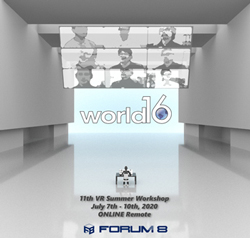 |
|
|
| ▲ Summer Workshop 2020 poster |
Every summer, the Summer Workshop has been held in various cities and regions all over the world by World16. Due to the COVID-19, it was held online this year. This is the report of the 4-day workshop.
What is World16?
World16 is a project run by 16 specialists on visualization / simulation of city model using VR. At the summer workshop, they aim at the revolutional R&D by using the common platform (VR Design Studio UC-win/Road). Different from academic conferences where researchers present their own study results, the summer workshop is the salong type by fixed few members. VR usage proposals has been presented and discussed at the International VR symposium by World16 consisting of architecture, civil engineering, and urban plan researchers around the world. So far, it has been held in Phoenix, the US (2008), Hakone, Japan (2009), Santa Barbara, the US (2010), Pisa, Italy (2011), Hawaii (2014), Thessaloniki, Greece (2015), Osaka (2016), Boston MIT (2017), New Zealand (2018), Paris (2019). The workshop this year was planned to be held in Taiwan at first, but in the spring we changed to host it online.
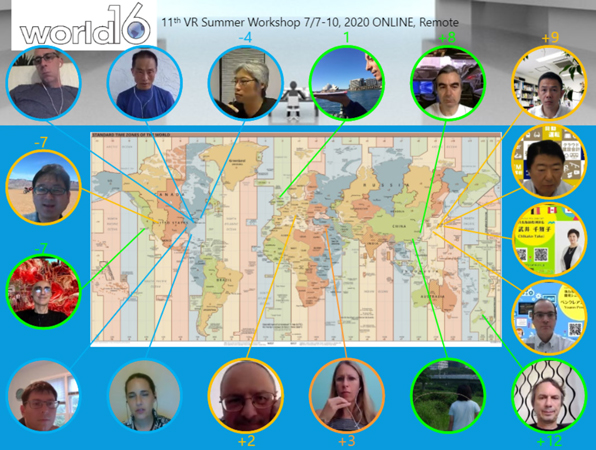 |
|
|
| ▲ Overcoming the time difference, the World16 members gathered online from 7 countries. |
Remote workshop
I had no idea what to do since it was the first time for us to get together online. I serched TIPS for online workshop and found that the following 5 contents are important.
- Participants are well prepared.
:We held a pre meeting.
- Reasonable schedule
:I made a schedule considering the time differences
- Use collaboration tools
:We used the Slack.
- Be considerate to others
:We communicated flexibly by using chat and other tools.
- Think of the facilitation
:We shared the To-do-list and simplified the task division.
My university in the US has started all lessons online since March by using a TV conference system called ZOOM meeting (zoom.us). Thanks to it, I had a confidence to correspond to troubles to some extent. Also, my experiences on the collaboration tools such as Slack, Trello, Discord, Git, and Google, which I have used at group projects toward graduation, helped me at the summer workshop.
One month before the workshop, I had a pre meeting on ZOOM with some members who were free. Through this meeting, I could know the projects in advance and select FORUM8 developers appropriate to each project. I could prepare well including the pre-check of the tools. The biggest problem was to make a schedule so that the members from all over the world could participate the workshop.
I used a map focusing on Japan with the world time differences written on and made a schedule so that each member could freely join presentations which were not important sessions. At the pre-conference, I sent messages on SNS to the members who forgot to attend. As the collaboration tool, I decided to use Slack (Slack.com), considering that each World16 member suggested own project and each FORUM8 developer supported several projects. The Slack is a chatting tool for a group of large amount of people and has the access permission setting for each group. The file sharing without using email helps the efficient comunication.
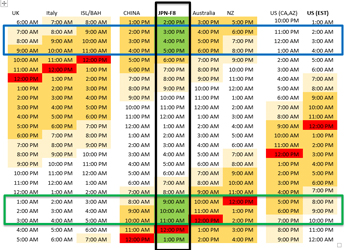 |
 |
|
|
▲ Time difference map: The workshops were held
at AM (green) and PM (blue) in Japan time every day.
|
▲ The members shared their presentations and workshop
contents and communicated on Slack. |
Day1 Opening
The workshop started at noon (JST) with the greeting by Mr. Yuji Ito, the CEO and President of FORUM8, and the keynote speech and the achievement presentations by FORUM8 staff followed it.
Mr. Ito told a variety of activities of FORUM8: The sales result of last year, winning of The 8th Monozukuri Award, new offices, activities of The State of the Art Technology Association, ICT Master Course, TV commercials that Pakkun appears, new suite series products (cloud accounting system, Suite Chidori Engine, Suite Data Eraser), the exhibitions that FORUM8 exhibited and will showcase at such as CES2020 and Siggraph Asia. After that, Mr. Pencreach Yoann, Development Manager of FORUM8, showed a demonstration of the 4D simulation function which has newly added to UC-win/Road. Since it is now possible to edit the project management status within the VR tool using the Gantt chart, further 4D VR usage can be expected. In addition, developing in C++ will realize the seamless development with general tools. He also introduced the Web version VR viewer under development.
This year's keynote speech named "Your Message Matters" was delivered by Prof. Toshihiko Yamazaki from University of Tokyo. Prof. Yamazaki and I met at a lecture 3 years ago and he has helped me with my overseas short-term lessons and the sabatical by Prof. Narahara, the member of World16. His speech was about 3 studies on the attract engineering using AI technologies.
The first research was a system that automatically evaluate presentation videos. The assessment results of TED presentations made by Mr. Bill Gates and Mr. Steve Jobs were interesting. The system detected "Convincing" element in the Mr. Gates' speech and "Attractive/Unique" in the Mr. Jobs' presentation.
Next, he talked about the study on the popularity on SNS. This is the research which # tag can get more "Like" for an image. For example, "#Smoking" attached to a photo of a smoking Portuguese man got about 4 times views than "#Portugual". Based on big data in Instagram, he developed an AI system that suggests tags to increase the number of access, and it has made efficient results actually.
The third study was about the image associativity. It was about a system that shows which fashion people watching the Starbacks images like. People who search the images of "McDonald" can be strongly associated with the words "time limited / carbonated water / fitness", and many of those often search the images of "Kentucky" think of "junk food / getting fat activity / spicy / garlic / oily noodle (all words are related to food)". By using these tendencies, the number of Like increased by almost 10 times.
In the Q&A session, he said that if we can know what kind of architectures are attractive/unattractive, we can use this system for the future plan in the architectural and urban fields.
Every year at the workshop, FORUM8 employees who got the encouragement award also do presentations on their work results. This year, the prize was given to Paul Barre, Naoki Fukushima, Erika Nakahata, Keisuke Sawahata, and Yasuhiro Iwakiri. They speeched their developments in English such as structure computing, cloud, Web apps, 4D tool, and learning AI.
Day2-3 Workshop
After the members finished their short presentations, the workshop started. We had ZOOM meetings from 9AM to 11AM and from 3PM to 5PM every day. But due to the time difference, the members did not have to attend all meetings and joined ones when they wanted to talk. They were asked to join the meetings once a day for greeting and progress report.
When they could not understand each other on the ZOOM meeting, they used tablets and draw their ideas to explain. This was a technique that I actually used at my lessons.
 |
|
|
| ▲ During the online workshop, the members explained their ideas by drawing and writing on tablet. |
Day4 Presentation
The result presentation on the final day was held from 11 to 12 in the morning and from 2 to 3:30 in the afternoon. The members mainly in the US did presentations at the first session and the members in EU did at the afternoon part. In this schedule, the morning session finished before the midnight in the US time, and the EU group could do presentations around 7 AM at the local time. The overview of each project are as below.
The idea of Prof. Thomas Tucker from Virginia Tech. was a VR system using five senses. He is aiming at creating a system that uses a motion sensor called VIVE tracker and allows you to experience interactive performances in VR space while actually touching objects made with 3D printer. He wants to use it for learning engineering such as engine disassembly as well as for art.
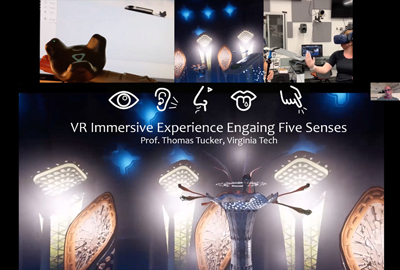 |
|
|
| ▲ Prof. Thomas Tucker (USA: Virginia Tech.) |
Prof. Ruth Ron from University of Miami is a member of a research project on VR usage for the treatment of trauma after traffic accidents. Although she was suggesting the utilization of UC-win/Road in that project, it is now postponed due to the COVID-19, and she suggested the test system of collision physical engine of UC-win/Road and vehicle accident in this workshop.
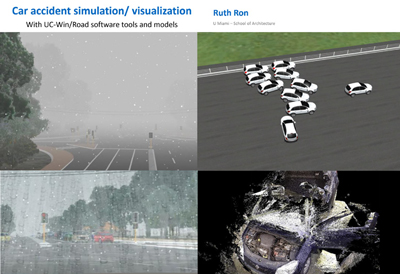 |
|
|
| ▲ Prof. Ruth Ron (USA: University of Miami) |
Prof. Fukuda, Osaka University, suggested the development of tool to test VR sickness. He implemented a shader that displays the relative speed and absolute speed of camera as warning colors in VR. He will conduct user testings and aim to develop a tool changing camera motions to prevent VR sickness.
 |
|
|
| ▲ Prof. Tomohiro Fukuda (Japan: Osaka University) |
Prof. Dongsoo Choi from Virginia Tech. developed a tool that calculates average normal from point clouds and displays RBG color according to its angle. Generally, point clouds are displayed in the color at the time of scanning or in a single color, but this makes it difficult to recognize data structure when displaying data of complex architecture and remains. In the future, he will test his system by using actual data and develop a system to change colors by simple operations.
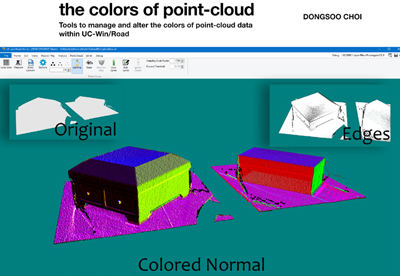 |
|
|
| ▲ Prof. Dongsoo Choi (Virginia Tech.) |
Prof. Matthew Swarts, Georgia Institute of Technology, is researching and developing a virus spreading simulation using the Agent model of COVID-19. He suggested an integrated system of UC-win/Road and it at this workshop. The system visualizes differences of infection hazardous level by changing wearing masks or not, social distancing, and moving routes of people.
 |
|
|
| ▲ Prof. Matthew Swarts (USA: Georgia Institute of Technology) |
The idea presented by Prof. Marcos Novac from University of California was a system that converts stereoscopic image into art expression in realtime by connecting UC-win/Road and the image conversion tool using AI.
 |
|
|
| ▲ Prof. Marcos Novac (USA: University of California) |
Prof. Marc Aurel Schnabel from Victoria University of Wellington suggested a system displaying a heat map to visualize what users looked at in the VR space. He developed a tool that creates a cube at the collision position after calculating the gaze and changes the color of it based on the length of gazing time.
 |
|
|
| ▲ Prof. Marc Aurel Schnabel (New Zealand: Victoria University of Wellington) |
The signal system that can optimize the time to wait for a traffic light by using RNN (Recurrent Neural Network AI) was presented by Prof. Kostas Terzidis from Tongji University. He expressed the amount of traffic waiting for a signal as Markov chain model of matrix data and developed a framework that can be embedded into the AI.
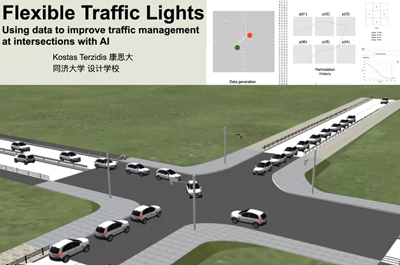 |
|
|
| ▲ Prof. Kostas Terzidis (China: Tongji University) |
Prof. Lo, Harbin Institute of Technology, proposed a tool which gets a camera and projected matrix and cooperate it with UC-win/Road . This tool is planned to be used for VR/AR applications that can be used on desks. This development is also testing the C++ framework.
 |
|
|
| ▲ Prof. Lo (China: Harbin Institute of Technology) |
Prof. Rebeka Vital from Shenkar College in Israel suggested another approach towards the issue of point cloud display. The tool she developed uses stroke (brush) images used in sketch software instead of a single color, so that no gap will be displayed between point clouds even when the camera is up close. Feeling the effect of the tool by testing it with actual models, she will make some improvements toward practice use.
 |
|
|
| ▲ Prof. Rebeka Vital (Israel: Shenkar College) |
Prof. Paolo Fiamma from University of Pisa suggested a tool for easy cost estimation of road designing by implementing an UI to edit and modify IFC data in UC-win/Road. He said that he will work on the development of the IFC edit tool in the future.
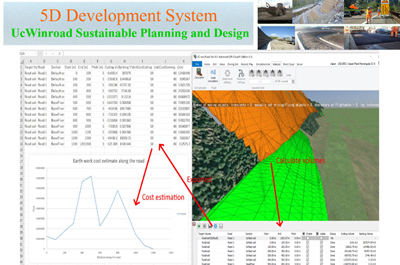 |
|
|
| ▲ Prof. Paolo Fiamma (Italy: University of Pisa) |
Prof. Amar Bennadji is developing a VR system of design competition at Robert Gordon University. Since FORUM8 was developing a new Web viewer, he assessed the tool and tested functions required in the future. The subject is the housing design, so he is planning to implement functions for efficient display such as expression of opening doors and unit designs in addition to the walkthrough function.
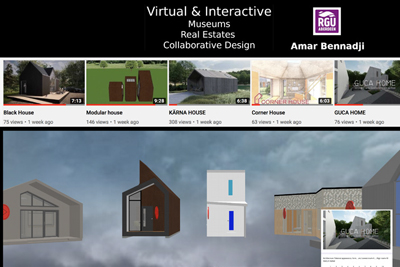 |
|
|
| ▲ Prof. Amar Bennadji (UK: Robert Gordon University) |
The projects suggested by the World16 members were more interesting than expected, and the first virtual workshop was so successful. As the encouragement award, all the workshop members were invited to the FORUM8 Design Festival in November.
Bonus content: VR tour
To let the members get away from the tense and mentally tiring presentations during the workshop, I prepared some relaxing time and tools. At the lunch time on Day4, I arranged a VR tour with the following activities that the members could join freely.
The Cluster (cluster.mu) is a virtual event online system where you can share your 3D space with many participants. This service is popular under the current COVID-19 pandemic situation because public events can also be held in addition to closed events where up to 50 members can join. Even beginners can create their own VR events in about an hour by just uploading FBX 3D space data file. In this VR tour, I held the "Dragon Searching Event" by using the city data which I use at my lessons and the tutorial dragon model preset in the FORUM8's Suite Chidori Engine.
 |
|
|
| ▲ cluster: People can gather at virtual spaces from various environments such as smartphone and PC. |
Spatial.Chat is an web group chat service and has also grown its popularity in this tough period. If you are chatting on ZOOM, only one person can talk at once. However, on the Spatial.Chat you can make a small chatting group in various places by putting your icon close to others' icons who you want to talk with.
 |
|
|
| ▲ Spatial.Chat: On this video chat service, you can enjoy talking with persons whose icons are close to yours. |
By using FaceRig, you can replace your face to 3D characters on ZOOM meeting. It costs about $8 and its realtime face recognition is popular among Youtubers. I changed my face to a racoon as a demonstration.
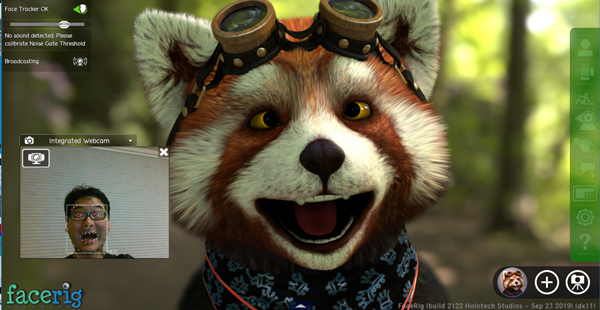 |
|
|
| ▲ Facerig: Facial expressions and face motions can be reflected on characters via a webcam. |
Translation of the Japanese page written by Assoc. Prof. Yoshihiro Kobayashi (Arizona State Univ.)
|


